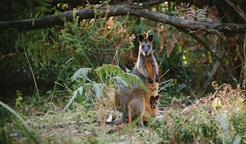The Sink campground
Abercrombie River National Park
Learn more
Learn more about why this park is special
The Sink campground is in Abercrombie River National Park. Here are just some of the reasons why this park is special:
Aboriginal culture

The ridgelines and rivers running through Abercrombie River National Park were once traditional travel and trading routes for the Wiradjuri and Gundungarra People. Evidence of open campsites can be found along the rivers and creeks in the park.
Action-ready

This is an environment built for adventure. One of the most popular activities in the park is 4WD touring. Some of the trails running along gorges and ridges can be pretty challenging, even for the experienced driver. For those with plenty of energy, you can also explore these trails on a mountain bike. The rivers and creeks, shaded by tall casuarinas, have plenty of deep waterholes. Pull on your swimmers and jump on in. Or perhaps you’ve got a canoe or kayak – bring it along because there are some good stretches for paddling.
Gold standard

Landscapes of deep gullies with rivers running through them – such as the one found at Abercrombie River – provide ideal conditions for loose gold. During the gold rush of the second half of the 1800s, the precious mineral was discovered here. Following the rivers and creeks you can find evidence – sluices and diggings – still there today.
Wild kingdom

All year round, this is a great spot to observe local wildlife. Kangaroos, wallabies and emus are seen throughout the park, and echidnas and wombats live on the slopes and river flats. The rivers and creeks are home to eastern water dragons and the shy platypus. In summer, you’ll hear the sound of frogs calling out near the creeks. There are also more than 60 species of birds around here – look for wedge-tail eagles soaring above Abercrombie trail.
Plants and animals protected in this park
Animals
-

Swamp wallaby (Wallabia bicolor)
The swamp wallaby, also known as the black wallaby or black pademelon, lives in the dense understorey of rainforests, woodlands and dry sclerophyll forest along eastern Australia. This unique Australian macropod has a dark black-grey coat with a distinctive light-coloured cheek stripe.
-

Bare-nosed wombat (Vombatus ursinus)
A large, squat marsupial, the Australian bare-nosed wombat is a burrowing mammal found in coastal forests and mountain ranges across NSW and Victoria. The only other remaining species of wombat in NSW, the endangered southern hairy-nosed wombat, was considered extinct until relatively recently.
-

Common ringtail possum (Pseudocheirus peregrinus)
Commonly found in forests, woodlands and leafy gardens across eastern NSW, the Australian ringtail possum is a tree-dwelling marsupial. With a powerful tail perfectly adapted to grasp objects, it forages in trees for eucalypt leaves, flowers and fruit.
Look out for...
Swamp wallaby
Wallabia bicolor

The swamp wallaby, also known as the black wallaby or black pademelon, lives in the dense understorey of rainforests, woodlands and dry sclerophyll forest along eastern Australia. This unique Australian macropod has a dark black-grey coat with a distinctive light-coloured cheek stripe.
